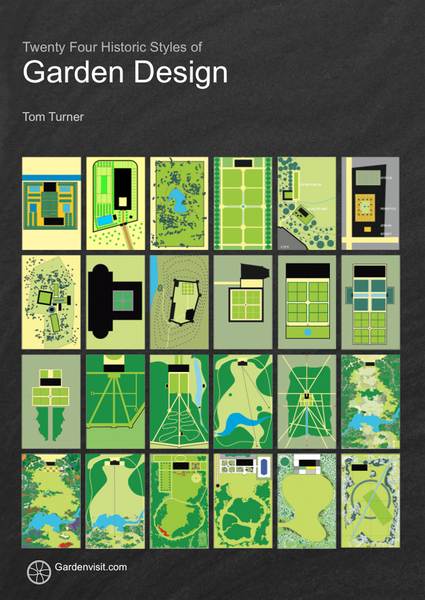I recently downloaded a copy of Tom Turner's 24 Historic Styles of Garden Design, published by Gardenvisit.com. Tom Turner was one of my teachers at Greenwich, on both the BA and MA programmes. In this book, Tom aims to provide "a short illustrated history of western garden design from 2000 BC to 2000 AD". "Western", in this context, includes Egypt, the middle east and northern India. If, like me, this subject is of particular interest to you then I recommend it: the text may be brief (and there are one or two typographic errors) but the accompanying illustrations- especially the style diagrams- are incredibly useful.
 |
| Cover of Twenty Four Historic Styles... via www.gardenvisit.com |
The style diagrams (illustrated on the cover, above) are part of a larger series that Tom Turner has been developing over many years. Clearly delineating how the elements of buildings, paving, vegetation and water are organised within each historic garden, they also imply, with a little bit of imagination, how these gardens may have been used. It occurred to me that they were also ripe for a bit of détournement- all in the best possible taste, of course.
So: every so often, I will select one of the twenty four diagrams at random, re-arrange it a little, then attempt to ascribe it to a time period or cultural movement.
GARDEN ONE:
What we might be looking at:
An irregular shape in light green, surrounded by a lighter colour. There is a suggestion of a perimeter wall. the irregular shape may be a consequence of landform- perhaps it is erected on top of a hill. Small dark green circles, most likely trees, are scattered across the plan.They seem able to cross the barrier between the light green and yellow areas- perhaps there is no wall at all, just a loosely defined fence.
A circular water feature sits at the centre of the plan, with other structures radiating out from this point. Closest to the fountain or poo are three small buildings, the largest of which is orientated on a north-south axis, adjacent to a wide avenue. This avenue connects two large, walled gardens: one running west-east, the other at slightly tilted to the north-west from the main axis.
The east-west walled garden contains a pool, and terminates in the east at a larger building, also facing east. No trees stand in front of this structure, perhaps giving it a commanding view from the top of the hill. This is most likely the main house.
The designer of this plan wants to invite the wild in from the outside, allowing it to run across the site (the trees), but is also keen to demarcate formal areas and keep them enclosed.
What we are actually looking at:
A classical villa, c100 AD. In the words of Tom Turner:
"Buildings and gardens were grouped together within a bounded enclosure. The spaces adjoining individual buildings were axially planned but, by the standards of renais sance villas, the lack of an axial relationship between buildings is surprising. Structures were scattered like parcels on a table. Either there was no overall plan or it was asymmetrical."
-Twenty Four Historic Styles of Garden Design , page 14
Twenty Four Historic Styles of Garden Design by Tom Turner can be downloaded at Google Play Books


No comments:
Post a Comment